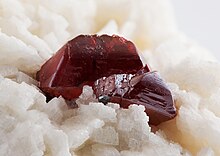Mercury(II) sulfide

Mercury(II) sulfide, also known as cinnabar, mercuric sulfide, and mercury sulfide, is a chemical compound. Its chemical formula is HgS. It has mercury and sulfide ions in it. The mercury is in its +2 oxidation state.
Properties[change | change source]
Mercury(II) sulfide is a red or black solid. It is found in two forms; cinnabar (alpha form) and metacinnabar (beta form). The alpha form is more common. The beta form is made when a mercury(II) salt like mercury(II) chloride reacts with hydrogen sulfide. It reacts with only the strongest acids to make hydrogen sulfide and a mercury(II) salt again. It does not dissolve in water. It breaks down to sulfur dioxide and mercury metal when heated.
Occurrence[change | change source]

Mercury(II) sulfide is found as the mineral cinnabar. It is the most common mercury mineral and mercury ore. It is a bright red mineral. It is soft and heavy.
Uses[change | change source]
Mercury(II) sulfide is what makes the pigment vermilion. It has been used as a pigment and as a mercury ore. It was used to make lacquerware, containers covered with lacquer. It is also used in traditional Chinese medicine.
